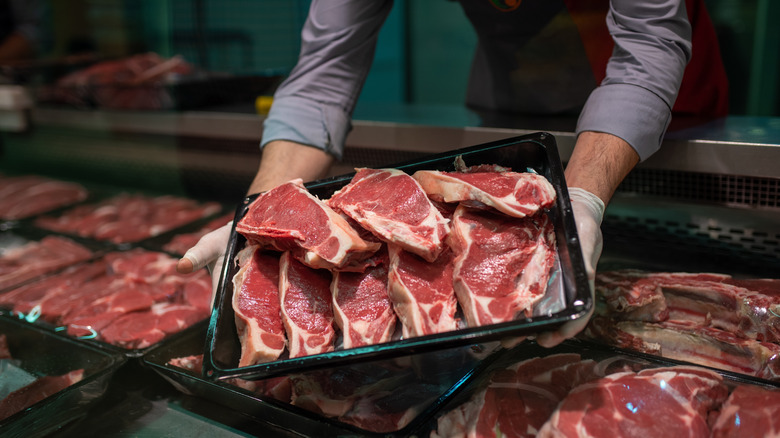Why Buying Bone-In Meat At The Grocery Store Might Be A Mistake
If you find yourself reaching for bone-in pork chops, T-bone steaks, or other meats at the grocery store, you may want to think twice about when you are planning on enjoying it. This bony choice could be a mistake if you're not going to roast or grill the protein soon after purchasing. In an exclusive interview, chef Richard Sandoval of Richard Sandoval Hospitality told Food Republic, "Bones can retain blood and marrow, which can speed up bacterial growth and shorten shelf life if not properly handled."
Sandoval isn't suggesting completely avoiding bone-in meats, though. "... Bones also add flavor and moisture when cooking — they act as a natural insulator and help the meat cook more evenly," he said. According to the expert, meat that contains bones are slightly more temperamental as far as timing is concerned, so don't forget about any cuts you might have hanging out in your refrigerator.
To make sure you're getting the freshest meat, Sandoval recommended always checking the smell, color, and sell-by date. "When shopping, look for vibrant color, tight packaging, and no off-odors," he said. "The bone should look clean and the meat around it shouldn't be discolored or overly soft." Additionally, look for dryness or sliminess, which can both indicate that the meat is not at its freshest and may even be spoiled.
How to source and handle bone-in meats
If you think your grocery store may not be stocking the freshest bone-in meat, Richard Sandoval suggested some alternatives. "I always recommend building a relationship with a trusted butcher — they can cut to your specifications and give you insight into quality sourcing," he told Food Republic. "Flash-frozen is also a great option if you're buying in bulk or want to ensure peak freshness."
Once you've procured your bone-in meat, be sure to avoid any of the common mistakes that can be made with raw meat. If you do purchase it from the grocery store, avoid making a beeline to the meat department when you enter the store. Instead, make it one of the last items you toss in the cart. Once you get home, be sure to store the protein properly. If you're going to cook it within a few days, pop the meat in the fridge on the bottom shelf. Not only is that one of the coldest parts of the refrigerator, it also prevents other foods from being contaminated, in the event that juices from the meat leak out of the packaging. If you need to keep any bone-in meat around for more than a few days, it should go in the freezer. Ideally, you'll want to repackage it using a vacuum sealer, but a freezer bag will work, too — just squeeze any air out before sealing. Label the new package with the date of storage, and place it alongside other frozen foods — this will allow your bone-in meat to last a whole lot longer without worry of any spoilage.


